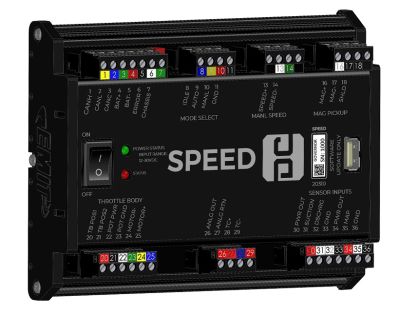Speed Overview
See the bottom part of this page for a general overview, or the articles below for specific topics.
Speed(Governor) Documents and Guide
Speed(Governor) Overview
Video available for this topic: https://www.youtube.com/watch?v=wzNx_1Ptvis
The EMIT Governor (Speed) module is an electronic speed control system for stationary carbureted natural gas engines. The Governor system consists of two main components: the control board and an electronic throttle body. The control board is intended to be mounted in a panel or EIM enclosure. The throttle body comes in a variety of sizes for different engines, and mounts directly between the carburetor and intake manifold.
The Governor works by monitoring the speed of the engine by reading a magnetic pickup (MPU) over the flywheel teeth. If the engine is running too slow or fast for the current control RPM, the throttle position is adjusted according to a PID control algorithm. The control speed is determined by a variety of conditions. First, the user can select through a panel switch one of three operating modes. They are “Idle,” “Manual,” or “Auto” speed control mode. In Idle mode, the Governor will hold the engine to an idle speed. In Manual mode, the user can increase or decrease the engine RPM, starting from the engine’s current speed, by using the “Speed+ / Speed-” switch on the panel. In Auto mode, the Governor control behavior will be determined in setup control mode, which may be configured to hold a fixed run speed or control to a certain compressor pressure.
Pressure control under Auto mode can either control to suction pressure or discharge pressure. In suction control mode the speed decreases as suction pressure drops and increases as the pressure rises. This is intended for wells or situations where the intake pressure varies but the downstream system can handle the discharge pressure changes. In discharge control mode, by contrast, the engine will increase speed if discharge pressure is too low, and lower speed if discharge pressure is too high. This aims to keep the discharge pressure constant.
